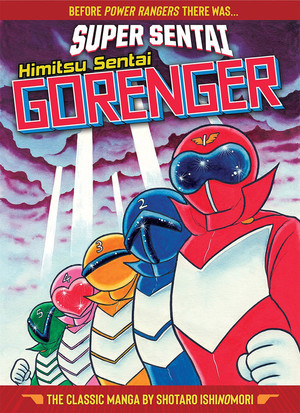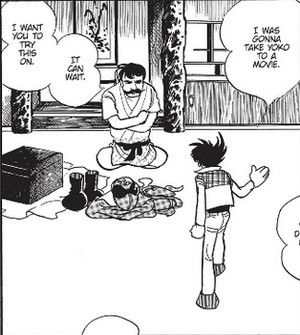The Spring 2021 Manga Guide
Himitsu Sentai Gorenger
What's It About?
 An evil secret society called the Black Cross Army threatens world peace, and only an elite task force known as the Earth Guard League (EAGLE) can stop them. After the Black Cross Army destroys EAGLE's headquarters across Japan, only five young recruits survive. Hiding in a secret underground base, they are given enhanced battlesuits that empower them with superhuman abilities, transforming the youths into an unstoppable squad to combat evil. (from Seven Seas)
An evil secret society called the Black Cross Army threatens world peace, and only an elite task force known as the Earth Guard League (EAGLE) can stop them. After the Black Cross Army destroys EAGLE's headquarters across Japan, only five young recruits survive. Hiding in a secret underground base, they are given enhanced battlesuits that empower them with superhuman abilities, transforming the youths into an unstoppable squad to combat evil. (from Seven Seas)Himitsu Sentai Gorenger is Shōtarō Ishinomori's manga tie-in to his own live-action tokusatsu (special-effects) series of the same name. The show, which premiered in 1975, is the first in the long-running Super Sentai tokusatsu series by Toei and TV Asahi. Ishinomori's manga serialized alongside the show in Shogakukan's Weekly Shonen Sunday magazine. Seven Seas has released the manga in large-trim hardcover for $24.99
Is It Worth Reading?

Rebecca Silverman
Rating:
I somehow missed the Power Rangers train when I was a kid. I'm honestly not sure how; probably I was too invested in my Teenage Mutant Ninja Turtles phase. But whatever the reason, not necessarily being familiar with that incarnation of the Super Sentai story isn't a huge detraction from enjoying the original manga by King of Manga Shōtarō Ishinomori, Himitsu Sentai Gorenger. This 1975 manga has a lot of appeal all on its own: certainly there's the manga history aspect, but the story and characters are also just a lot of fun in a Saturday morning cartoon kind of way. The villains are appropriately evil (and show no remorse, ever), the heroes are all distinct and have their own roles to play, and there's a cool plane that has a cat face with fangs. What more could you want?
Possibly the answer is “for peggy/Momorenger to do more,” but I think we'll just go ahead and blame 1975 for that. It's true that Momorenger is very much The Girl in both of the included storylines (from two different magazines); even if we ignore the big heart on her mask that functions as her window to the world, she has many fewer moments of action. But in all fairness, our ostensible main hero Tsuyoshi/Akarenger doesn't do a whole lot either, and in fact, when he decides to go off on his own in the second half of the book, he winds up needing the rest of the team to come and rescue him. The show really belongs to Midorenger and Kirenger, the green and yellow of the group respectively. The two of them have a sort of manzai comedy theme, with Akira/Midorenger posing riddles for Daita/Kirenger to puzzle out while he's inhaling ten plates of curry. They get the most action on the page as well, often accompanied by their signature statements about food and riddles, and their chemistry does make it easy to forget that the blue ranger (Shinmei/Aorenger) even exists for long stretches of the book.
That said, Shinmei does get the biggest emotional moment, since it's his former best friend who betrays the Gorengers to the evil Black Cross. It's striking to note that unlike in most modern series aimed at the elementary school set, Shinmei actually kills his old friend, shooting him in the heart, and then announces to the audience that he's prepared to let Black Cross' tanks take him out as well, so that his friend won't go into death alone. The Gorengers do stop him on that last front, but no one thinks he did the wrong thing in killing the man who betrayed them all, which is not a sentiment I'd expect to see in a book written today. Likewise, Tsuyoshi's father and his disciples are all murdered by the Black Cross' minions at the start of the story, making this fairly dark all around.
These elements are slightly counteracted by the whole Mido-and-Kirenger duo and the goofy masks that Black Cross agents wear, but even the very cartoony art can't take away from the fact that this is a serious story, albeit one with a heavy-handed message about environmentalism and the power of solar energy. It's a good read, and Ishinomori's art is dynamic despite looking old-fashioned to modern readers. Even if you missed the Power Rangers as a kid, this is worth picking up, because not only does it give a good idea of where things came from, it's also still a darn good story.
discuss this in the forum (52 posts) |
this article has been modified since it was originally posted; see change history
back to The Spring 2021 Manga Guide
Feature homepage / archives